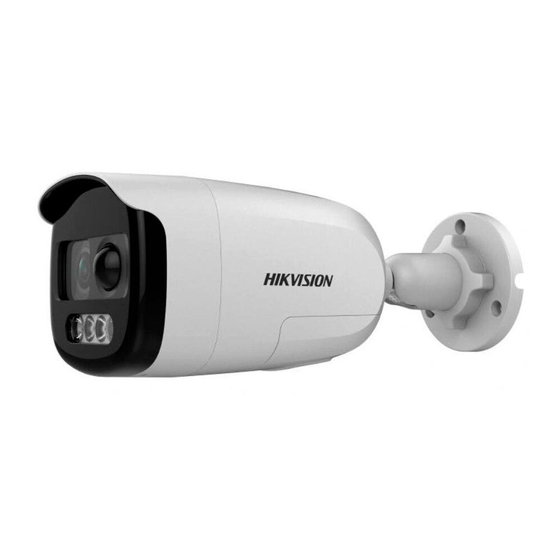
Table of Contents
Advertisement
Quick Links
Full Time Color Camera
User Manual
Thank you for purchasing our product. If there are any
questions, or requests, do not hesitate to contact the
dealer.
This manual applies to the models below:
Type I Camera
Type II Camera
This manual may contain several technical mistakes or
printing errors, and the content is subject to change
without notice. The updates will be added to the new
version of this manual. We will readily improve or
update the products or procedures described in the
manual.
Type
2 MP PIR Siren
User Manual
DS-2CE12DFT-PIRXOF
DS-2CE12DFT-PIRXOF28
DS-2CE72DFT-PIRXOF
DS-2CE72DFT-PIRXOF28
Model
01000020201211
Advertisement
Table of Contents

Subscribe to Our Youtube Channel
Summary of Contents for HIKVISION DS-2CE12DFT-PIRXOF28
- Page 1 This manual applies to the models below: Type Model DS-2CE12DFT-PIRXOF Type I Camera DS-2CE12DFT-PIRXOF28 DS-2CE72DFT-PIRXOF Type II Camera DS-2CE72DFT-PIRXOF28 This manual may contain several technical mistakes or printing errors, and the content is subject to change without notice. The updates will be added to the new version of this manual.
-
Page 2: Regulatory Information
Regulatory Information FCC Information Please take attention that changes or modification not expressly approved by the party responsible for compliance could void the user’s authority to operate the equipment. FCC compliance: This equipment has been tested and found to comply with the limits for a Class A digital device, pursuant to part 15 of the FCC Rules. - Page 3 Safety Instruction Warnings In the use of the device, you must be in strict compliance with the electrical safety regulations of the nation and region. Input voltage should meet both the SELV (Safety Extra Low Voltage) and the Limited Power Source with 12 VDC according to the IEC60950-1 standard and IEC62368-1 standard.
- Page 4 OSD menu with configurable parameters 24-hour color image Smart light PIR detection Built-in speaker 1.2 Overview 1.2.1 Overview of Type I Camera Switch Button Alarm Cable Video Cable Bracket Power Cord Lens Main Body Siren Figure 1-1 Overview of Type I Camera Note: Press and hold the switch button for 5 seconds to...
-
Page 5: Installation
2 Installation Before you start Make sure that the device in the package is in good condition and all the assembly parts are included. Make sure that all the related equipment is power-off during the installation. Check the specification of the products for the ... - Page 6 Note: The supplied screw package contains self-tapping screws, and expansion bolts. For cement wall/ceiling, expansion bolts are required to fix the camera. For wooden wall/ceiling, self-tapping screws are required. 5. Connect the corresponding power cord and video cable. 6.
- Page 7 5. Secure the junction box’s body on the ceiling/wall with supplied screws. Figure 2-6 Secure the Junction Box on the Wall/Ceiling 6. Route the cables through the bottom cable hole or the side cable hole of the junction box. 7. Combine the junction box cover with its body. Figure 2-7 Combine the Junction Box Cover with Body 8.
- Page 8 Figure 2-9 Pry the Mounting Base 3. Paste the drill template (supplied) to the place where you want to install the camera. Figure 2-10 Drill Template Note: Drill the cable hole, when adopting the ceiling outlet to route the cable. 4.
- Page 9 Pan Position [0° to 360°] Tilt Position Rotation Position [0° to 75°] [0° to 360°] Figure 2-13 3-Axis Adjustment 1). Rotate the enclosure to adjust the pan position [0° to 360°]. 2). Move the camera body up and down to adjust the tilt position [0°...
- Page 10 Figure 2-16 Secure the Junction Box’s Body 6. Route the cables through the bottom cable hole, or the side cable hole of the junction box. 7. Combine the junction box’s cover with its body. 8. Repeat the step 6 to 8 of 2.2.1 Ceiling/Wall Mounting without Junction Box to finish the installation.
-
Page 11: Menu Description
3 Menu Description Please follow the steps below to call the menu. NOTE: The actual display may vary with your camera model. Steps: 1. Connect the camera with the TVI DVR, and the monitor, shown as the figure 3-1. Figure 3-1 Connection 2. -
Page 12: Video Format
1). Click up/down direction button to select the item. 2). Click Iris + to confirm the selection. 3). Click left/right direction button to adjust the value of the selected item. 3.1 VIDEO FORMAT You can set the video format to 2MP@25fps or 2MP@30fps. -
Page 13: Image Mode
VIDEO SETTINGS IMAGE MODE WHITE BALANCE BRIGHTNESS CONTRAST SHARPNESS SATURATION 3DNR MIRROR BACK EXIT SAVE & EXIT Figure 3-3 VIDEO SETTINGS IMAGE MODE IMAGE MODE is used to adjust the image saturation, and you can set it to STD (Standard) or HIGH-SAT (High Saturation). - Page 14 between two frames besides processing the noise in one frame. The noise will be much less and the video will be clearer. MIRROR OFF, H, V, and HV are selectable for mirror. OFF: The mirror function is disabled. H: The image flips 180° horizontally. V: The image flips 180°...
-
Page 15: Factory Default
3.5.7 DPC DPC refers to defective pixel correction. Defective pixels are pixels on a display that are not performing as expected. This function is used to correct pixels like that. 3.6 FACTORY DEFAULT Reset all the settings to the factory default. 3.7 EXIT Move the cursor to EXIT and click Iris+ to exit the menu.












Need help?
Do you have a question about the DS-2CE12DFT-PIRXOF28 and is the answer not in the manual?
Questions and answers